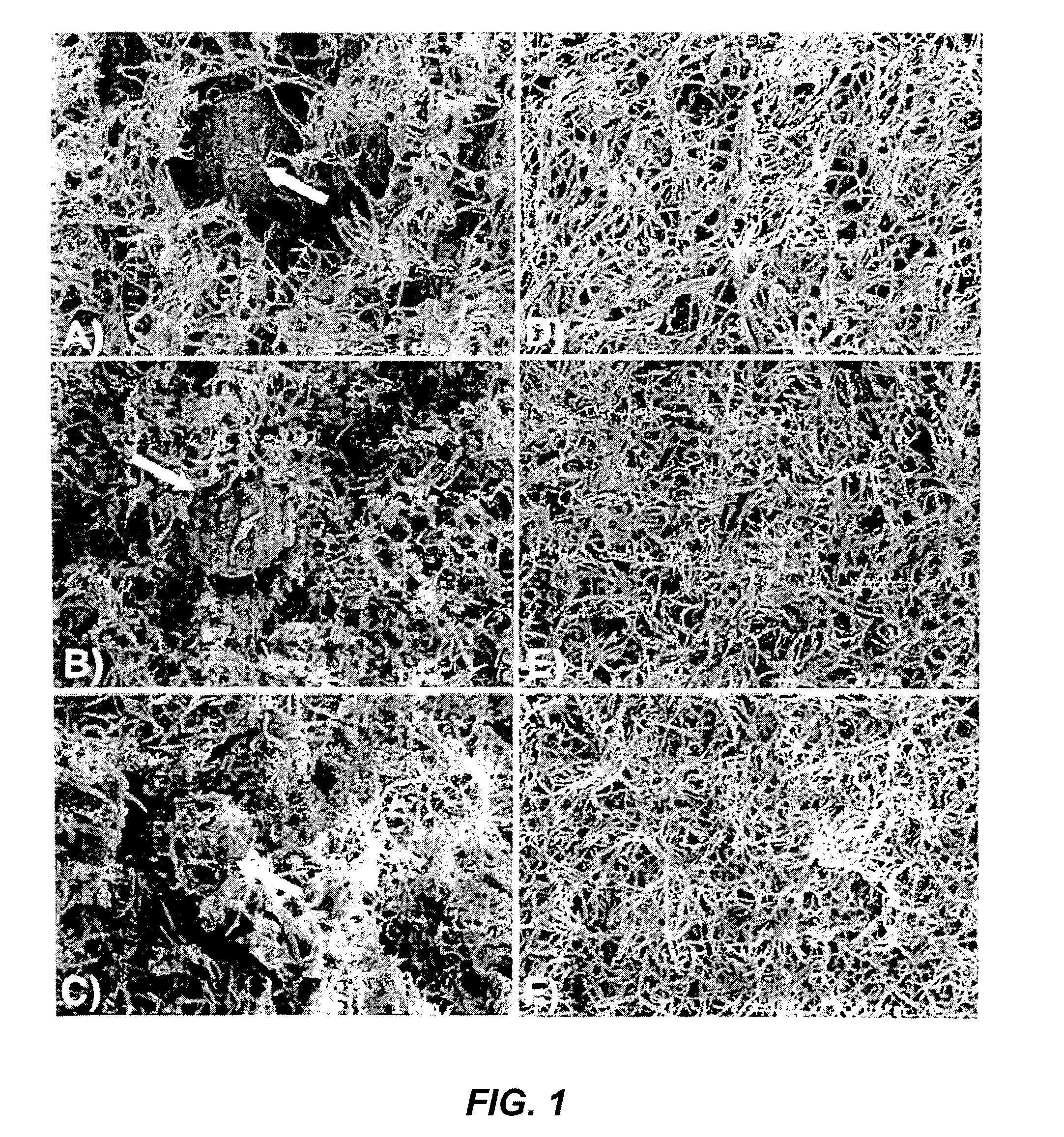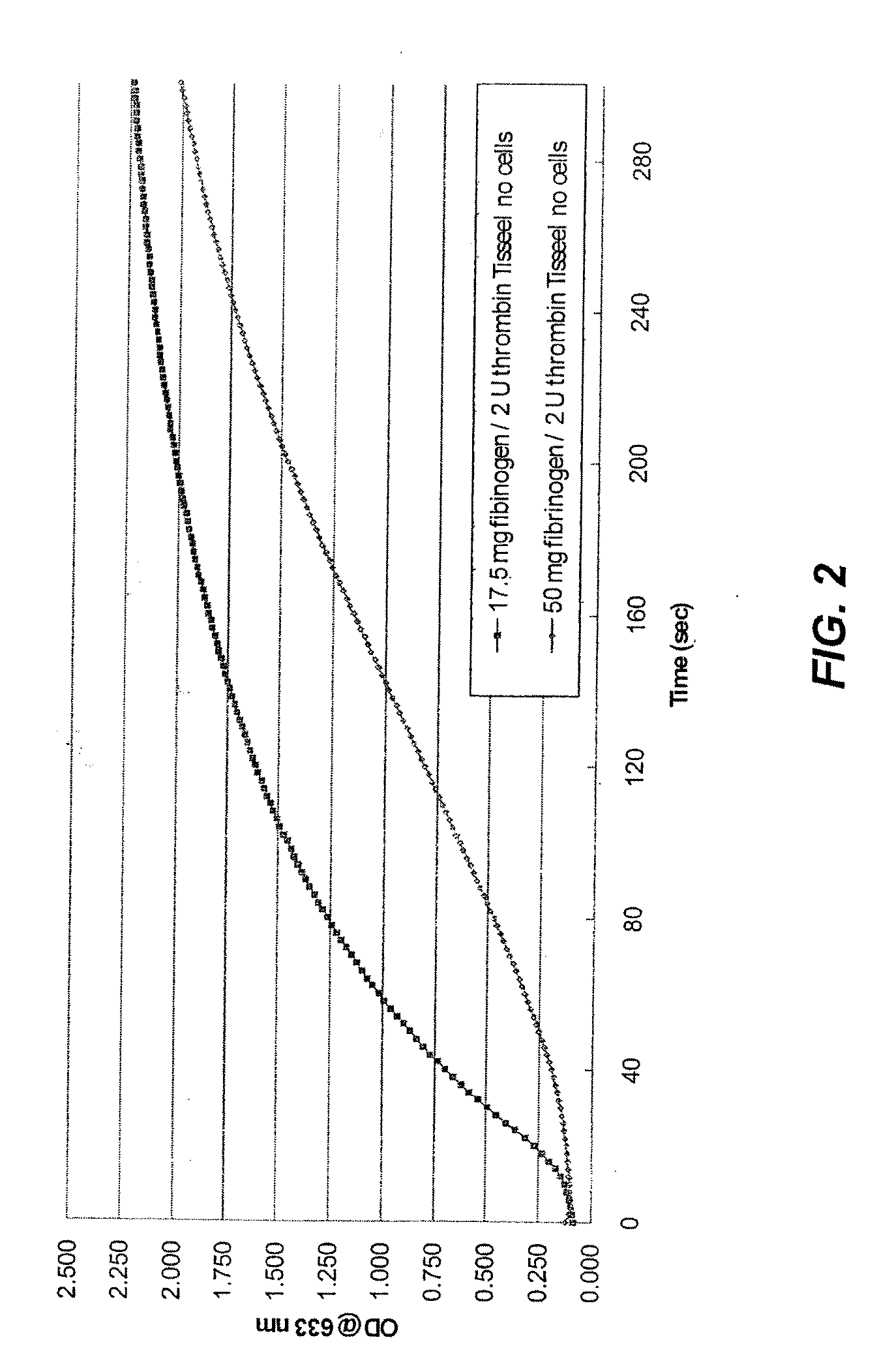Using of scaffold comprising fibrin for delivery of stem cells
a technology of fibrin and stem cells, which is applied in the direction of biocide, prosthesis, drug composition, etc., can solve the problems of inability to retain cells at the transplanted site or support their proliferation in situ, and achieve enhanced and distinct cell attachment cell viability, gene and protein expression in cells, and chemokine-induced migration.
- Summary
- Abstract
- Description
- Claims
- Application Information
AI Technical Summary
Benefits of technology
Problems solved by technology
Method used
Image
Examples
example 1
Preparation of Mononuclear Cells for CD34+ Cell Selection
[0073]This Example describes how to reduce red cells from whole blood (approximately 90%) and how to isolate mononuclear cells (MNC) in umbilical cord blood. Single or pooled cord blood (CB) samples ranging from 48-72 hours old and 40-100 mls in volume were obtained with parental consent. MNC from CB were prepared at a dilution of 1 in 5 with 1 ml of 6% hetastarch (Baxter Healthcare Corp., Deerfield, Ill.) to every 5 ml of unseparated CB. The mixture was allowed to settle for a minimum of 1 hour at room temperature. The plasma fraction containing MNC was then transferred into a 50 ml conical tube and pelleted by centrifugation for 7 to 10 minutes. MNC were resuspended with approximately 35 mls of calcium / magnesium-free phosphate buffered saline (CMF-PBS) (Lonza Corp., Walkersville, Md.) and then underlayed with 12-15 mls of Histopaque-1077 (Sigma Chemical, St. Louis, Mo.). After 20-30 minutes of centrifugation at 400×g, the MN...
example 2
Selection of CD34+ Cells from Umbilical Cord Blood
[0074]This Example describes how to select and purify CD34+ cells from umbilical cord blood MNC using the EasySep® human CD34+ cell selection kit (Stem Cell Technologies, Vancouver, Canada). The CD34 antibody was added at 100 μl / ml per every 1×108 cells or 2×108 cells. The antibody and cells were mixed well, and then incubated at room temperature for 15 minutes. Magnetic nanoparticles were then added at 50 μl / ml. The cells and nanoparticles were mixed well, and then incubated at room temperature for 10 minutes. The cell / nanoparticle mixture was resuspended with Buffer (+EasySep Kit) at 2.5 ml. The cells were placed in a tube and then into the EasySep® magnet and allowed to set for 5 minutes. In one continuous motion, the magnet and tube were inverted while pouring off the supernatant fraction. The magnetically labeled CD34+ cells remained inside the tube, held by the magnetic field of the magnet while the unwanted (non-magnetic cells...
example 3
Preparation of Fibrin Gel from Tisseel® VHSD
[0075]This Example describes how to prepare fibrin gel from Tisseel® VHSD (Baxter International Inc.), a next generation fibrin sealant, developed with an added virus inactivation step (solvent / detergent [S / D] treatment) to provide added safety and convenience to the currently licensed Tisseel® product. The fibrinogen component Tisseel® VHSD (sealer protein) was resuspended with 5 mls of aprotinin and then placed in the fibrinotherm at 37° C. until dissolved. Undiluted stock was prepared at a concentration of 100 mg / ml of fibrinogen and diluted 1:4 to a concentration of 25 mg / ml with fibrinogen dilution buffer (FDB). FDB contains 3000 KIU / ml aprotinin, 25 mM sodium citrate, 48 mM sodium chloride, 333 mM glycine, and 15 g / L human serum albumin. Diluted fibrinogen was then dispensed at 100 μl into individual wells of a 24-well plate. Stock thrombin was prepared in 5 mls of calcium chloride to 500 U / ml and then diluted to 4 U / ml in thrombin d...
PUM
| Property | Measurement | Unit |
|---|---|---|
| concentration | aaaaa | aaaaa |
| concentration | aaaaa | aaaaa |
| concentrations | aaaaa | aaaaa |
Abstract
Description
Claims
Application Information
 Login to View More
Login to View More - R&D
- Intellectual Property
- Life Sciences
- Materials
- Tech Scout
- Unparalleled Data Quality
- Higher Quality Content
- 60% Fewer Hallucinations
Browse by: Latest US Patents, China's latest patents, Technical Efficacy Thesaurus, Application Domain, Technology Topic, Popular Technical Reports.
© 2025 PatSnap. All rights reserved.Legal|Privacy policy|Modern Slavery Act Transparency Statement|Sitemap|About US| Contact US: help@patsnap.com



